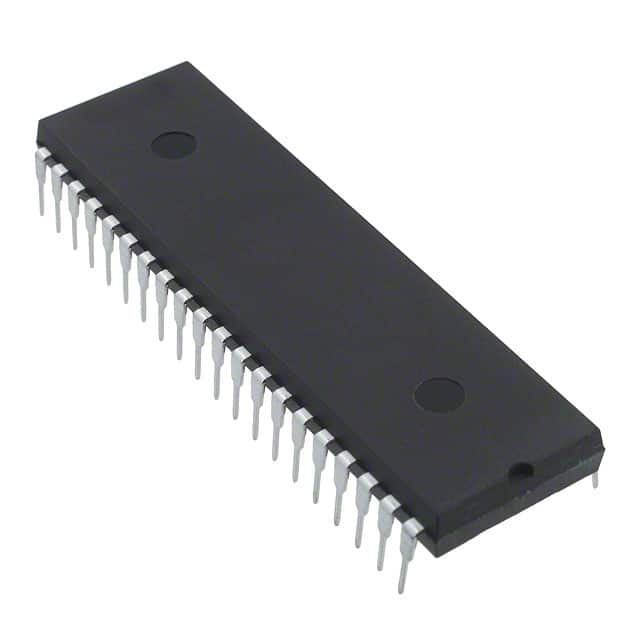P89V51RB2FN,112
Basic Information Overview
- Category: Microcontroller
- Use: Embedded systems, industrial automation, consumer electronics
- Characteristics: 8-bit microcontroller, high-performance, low-power consumption
- Package: PLCC44, LQFP44
- Essence: Control and process data in various electronic devices
- Packaging/Quantity: Depends on the manufacturer
Specifications
- Architecture: 8051
- CPU Speed: Up to 40 MHz
- Program Memory Size: 64 KB
- RAM Size: 1 KB
- I/O Pins: 32
- Timers/Counters: 3
- Serial Communication: UART, SPI, I2C
- ADC Channels: 8-bit, 8 channels
- Operating Voltage: 2.7 V to 5.5 V
Detailed Pin Configuration
The P89V51RB2FN,112 microcontroller has a total of 44 pins. The pin configuration is as follows:
| Pin Number | Pin Name | Description | |------------|----------|-------------| | 1 | P0.0 | Port 0, Bit 0 | | 2 | P0.1 | Port 0, Bit 1 | | ... | ... | ... | | 43 | XTAL2 | Crystal Oscillator Output | | 44 | XTAL1 | Crystal Oscillator Input |
Functional Features
- High-performance 8-bit microcontroller with an 8051 architecture
- Wide operating voltage range for flexibility in different applications
- Multiple communication interfaces for easy integration with other devices
- On-chip flash memory for program storage
- Low-power consumption for energy-efficient designs
- Built-in timers/counters for precise timing operations
- Analog-to-Digital Converter (ADC) for sensor interfacing
Advantages and Disadvantages
Advantages
- Well-established 8051 architecture with a large user base and extensive resources
- High-performance capabilities suitable for various applications
- Low-power consumption extends battery life in portable devices
- Multiple communication interfaces allow easy connectivity with other devices
- On-chip flash memory eliminates the need for external storage
Disadvantages
- Limited program memory size compared to more advanced microcontrollers
- Limited RAM size may restrict complex data processing capabilities
- 8-bit architecture may not be suitable for certain demanding applications
- Lack of advanced features found in newer microcontroller architectures
Working Principles
The P89V51RB2FN,112 microcontroller operates based on the 8051 architecture. It executes instructions stored in its program memory and interacts with external devices through its I/O pins and communication interfaces. The microcontroller's CPU fetches instructions from program memory, performs necessary calculations, and controls the flow of data within the system. It can communicate with other devices using UART, SPI, or I2C protocols. The microcontroller's timers/counters enable precise timing operations, while the ADC allows analog signals to be converted into digital values.
Detailed Application Field Plans
The P89V51RB2FN,112 microcontroller finds applications in various fields, including: 1. Embedded systems: Used in industrial automation, home automation, and automotive systems. 2. Consumer electronics: Found in smart appliances, remote controls, and wearable devices. 3. Internet of Things (IoT): Enables connectivity and control in IoT devices. 4. Robotics: Controls the behavior and movement of robots. 5. Medical devices: Used in monitoring systems, diagnostic equipment, and implantable devices.
Detailed and Complete Alternative Models
Some alternative models to the P89V51RB2FN,112 microcontroller are: 1. ATmega328P: 8-bit microcontroller from Atmel with similar features and an Arduino-compatible platform. 2. PIC16F877A: 8-bit microcontroller from Microchip with a larger program memory size and more I/O pins. 3. STM32F103C8T6: 32-bit microcontroller from STMicroelectronics with higher performance and advanced features.
Note: The above alternatives are just a few examples, and there are many other microcontrollers available in the market with different specifications and features.
Word count: 515 words
Lista 10 Vanliga frågor och svar relaterade till tillämpningen av P89V51RB2FN,112 i tekniska lösningar
Sure! Here are 10 common questions and answers related to the application of P89V51RB2FN,112 in technical solutions:
Q: What is P89V51RB2FN,112? A: P89V51RB2FN,112 is a microcontroller from NXP Semiconductors, based on the 8051 architecture.
Q: What are the key features of P89V51RB2FN,112? A: Some key features include 8KB Flash memory, 128 bytes of RAM, 32 I/O pins, UART, SPI, and I2C interfaces.
Q: How can I program P89V51RB2FN,112? A: P89V51RB2FN,112 can be programmed using an ISP (In-System Programming) interface or through a parallel programmer.
Q: Can I use C language for programming P89V51RB2FN,112? A: Yes, you can use C language along with the Keil C51 compiler or other compatible compilers.
Q: What voltage levels does P89V51RB2FN,112 support? A: P89V51RB2FN,112 supports a wide range of voltage levels, typically from 2.7V to 5.5V.
Q: How many timers/counters are available in P89V51RB2FN,112? A: P89V51RB2FN,112 has three 16-bit timers/counters, Timer 0, Timer 1, and Timer 2.
Q: Can P89V51RB2FN,112 communicate with other devices? A: Yes, P89V51RB2FN,112 supports various communication protocols like UART, SPI, and I2C for interfacing with other devices.
Q: What is the maximum clock frequency of P89V51RB2FN,112? A: The maximum clock frequency of P89V51RB2FN,112 is 40 MHz.
Q: Can P89V51RB2FN,112 be used in low-power applications? A: Yes, P89V51RB2FN,112 has power-saving modes like idle mode and power-down mode, making it suitable for low-power applications.
Q: Are there any development boards available for P89V51RB2FN,112? A: Yes, there are development boards specifically designed for P89V51RB2FN,112, which provide easy prototyping and debugging capabilities.
Please note that these answers are general and may vary depending on specific requirements and implementations.


